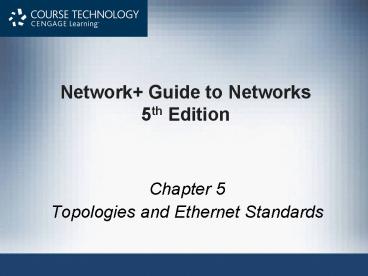Network Guide to Networks 5th Edition - PowerPoint PPT Presentation
1 / 29
Title:
Network Guide to Networks 5th Edition
Description:
May or may not travel through intervening connectivity device ... Figure 5-13 A 10Base-T network. Network Guide to Networks, 5th Edition. 27 ... – PowerPoint PPT presentation
Number of Views:86
Avg rating:3.0/5.0
Title: Network Guide to Networks 5th Edition
1
Network Guide to Networks5th Edition
- Chapter 5
- Topologies and Ethernet Standards
2
Objectives
- Describe the basic and hybrid LAN physical
topologies, and their uses, advantages, and
disadvantages - Describe the backbone structures that form the
foundation for most LANs - Understand the transmission methods underlying
Ethernet networks - Compare the different types of switching used in
data transmission
3
Simple Physical Topologies
- Physical topology
- Physical layout of network nodes
- Does not specify
- Device types
- Connectivity methods
- Addressing schemes
- Fundamental shapes
- Bus, ring, star
- Hybrid
4
Bus Topology
5
Bus Topology
- Single cable connects all network nodes(No
intervening connectivity devices) - One shared communication channel
- Physical medium Coaxial cable
- Passive topology
- Node listens for, accepts data
- Uses broadcast to send
6
Bus Topology (contd.)
- Advantage relatively inexpensive
- Disadvantages
- Does not scale well
- Difficult to troubleshoot
- Not very fault tolerant
7
Ring Topology
8
Ring Topology
- Circular network with clockwise data
transmission - Active topology
- Workstation participates in data delivery
- Data stops at destination
- Physical medium options
- Twisted pair
- Fiber-optic
- Drawbacks
- Malfunctioning workstation can disable network
- Not flexible or scalable
9
Star Topology
- Most popular physical topology
- Most Ethernet networks are based on star topology
10
Star Topology
- Node connects through central device
- Physical medium options
- Twisted pair
- Fiber-optic
- Advantages
- Fault tolerance
- Very Scalable
11
Logical Topologies
- Describes data transmission between nodes
- Most common bus, ring
- Bus logical topology
- Signals travel from one device to all other
devices - May or may not travel through intervening
connectivity device - Bus logical topology used by networks with
- Physical bus topology
- Star, star-wired bus topology
- Ethernet
12
Logical Topologies (contd.)
- Ring logical topology
- Signals follow circular path
- Ring logical topology used by networks with
- Pure ring topology
- Star-wired ring hybrid physical topology
- Token ring
13
Hybrid Physical Topologies
- Pure bus, ring, star topologies rarely exist
because they are too restrictive - Hybrid topology are more likely
- Complex combination of simple topologies
- Several options
14
Star-Wired Ring
- Combines a star physical topology with a ring
logical topology - Benefit stars fault tolerance
- Token Ring (IEEE 802.5) networks use this
15
Star-Wired Ring (contd.)
16
Star-Wired Bus
- Combines a physical star with a logical bus
- Advantages
- Cover longer distances
- Easily interconnect, isolate different segments
- Drawbacks
- Requires lots of cabling
- Cost of connectivity device(s)
- Hub-based Ethernet networks use this
17
Star-Wired Bus (contd.)
18
Backbone Networks
- Connects hubs, switches, routers(not end-user
devices) - More throughput needed on backbone than to the
desktops
19
Serial Backbone
20
Distributed Backbone
21
Collapsed Backbone
22
Parallel Backbone
23
Switching
- Logical network topology component
- Determines connection creation between nodes
- Three methods
- Circuit switching
- Message switching
- Packet switching
24
Ethernet
- Developed by Xerox in the 1970s, then improved by
Digital Equipment Corporation (DEC), Intel, Xerox
(DIX), and others - Excellent throughput for reasonable cost makes
this the most popular LAN technology - All variations share common access method
(CSMA/CD)
25
CSMA/CD (contd.)
26
Ethernet Standards for Copper Cable
27
Ethernet Standards for Copper Cable
28
Summary of Common Ethernet Standards
29
Ethernet Frames

